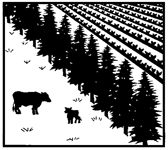U.S. Department of Agriculture: Forest Service -- National Agroforestry Center
Date of this Version
December 2000
Abstract
The demand for wood products and wood fiber has led to the development of a production system based on fast growing trees known as Short Rotation Woody Crops (SRWCs). Traditionally, SRWCs are grown in large, intensively managed blocks, but the technology may also be used on agricultural lands in integrated applications such as timberbelts. Timberbelts are multiple row windbreaks that are planted with commercially valuable trees to produce wood products. Trees such as hybrid poplar (typically cottonwood and to a lesser extent aspen), hybrid willow, hybrid pine, paulownia, etc., are particularly suited for use in timberbelts because of their rapid growth, expanding array of marketable products, growing demand for alternative sources of wood fiber, and generation of earlier investment returns.
Timberbelts can improve net farm income, sequester carbon, enhance wildlife habitat, and improve water quality. They serve as windbreaks to reduce soil erosion, increase crop yields and improve public safety through enhanced snow management. Other benefits include diversifying farming systems and agricultural landscapes, improving soil quality, reducing the input and transport of agricultural chemicals and fertilizers, and improving local air quality. Because of their multi-purpose objective including protecting adjacent crops from the wind and producing wood products, timberbelts are an agroforestry practice that is also a profit center for the farm. Trees can reach between 50 to 80 feet in height at age 10, depending on site conditions, irrigation, and management. Rotation age can range from 10 to 20 years. Producing a direct income from these windbreaks diversifies sources of farm revenue and reduces overall financial risk.
Figure 1 illustrates the timberbelt concept. In this example, an evergreen row is placed on the windward side of each timberbelt for year-round protection. All poplar rows could be harvested at the end of the rotation (7 to 12 years), or some rows could be left for crop protection until the harvested rows regrow and are of sufficient height to provide effective wind reduction. For maximum wind protection, timberbelts should be spaced across the field at 10 to 15 times the height of the timberbelt at the age it is to be harvested. Specific spacings between timberbelts should be at even multiples of the width of the largest agricultural implements (e.g., sprayers).


Comments
Published by National Agroforestry Center, USDA Forest Service, Rocky Mountain Station, USDA Natural Resources Conservation Service, East Campus – UNL, Lincoln, Nebraska 68583-0822.